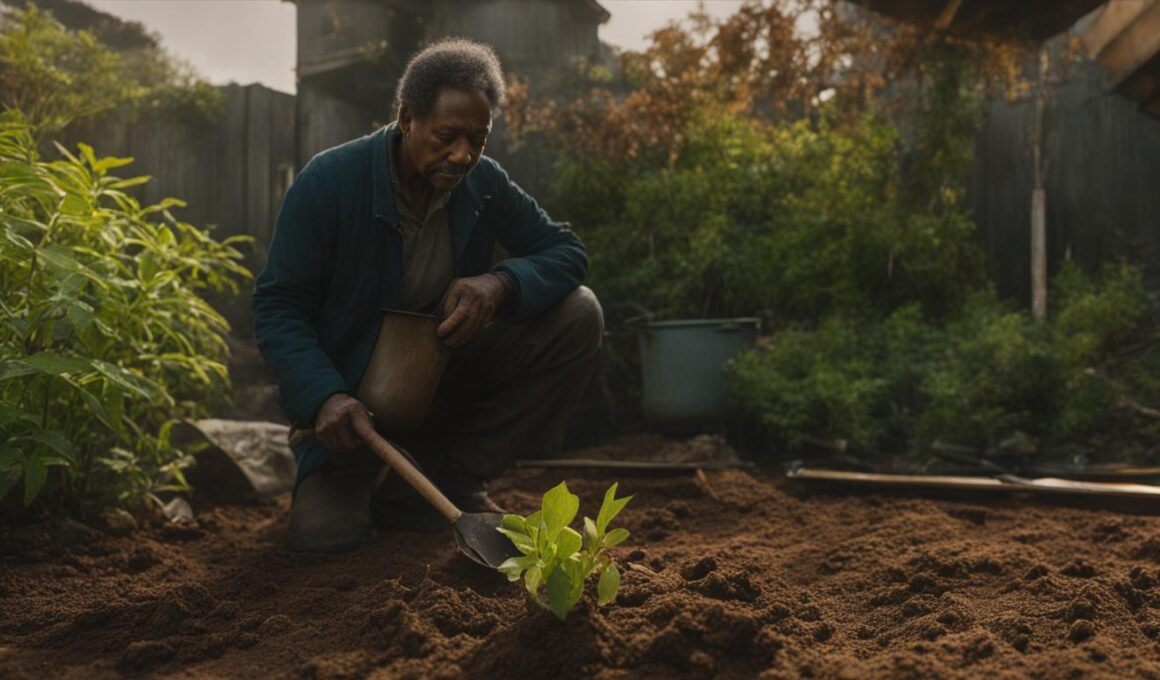Iron chlorosis, a common problem in plants, can hinder their growth and overall health. Iron deficiency leads to yellowing of leaves, reduced vigor, and increased susceptibility to diseases and pests. To enhance plant growth and maintain a healthy garden, it is crucial to address iron chlorosis effectively.
Post Summary
- Iron chlorosis can result in yellowing of leaves and reduced plant vigor.
- Factors contributing to iron chlorosis include high pH levels, over-watering, and soil compaction.
- Techniques to reduce iron in soil include soil pH adjustment, iron additives, and foliar applications.
- Proper plant selection and soil management are crucial in preventing iron chlorosis.
- Regular monitoring and soil testing are recommended for effective iron chlorosis management.
Symptoms and Causes of Iron Chlorosis
Iron chlorosis, characterized by yellowing leaves and interveinal chlorosis, is a common issue in plants. Understanding the symptoms and causes of iron chlorosis is essential for effective management and prevention. By identifying these signs, you can take the necessary steps to address iron deficiency in your soil and promote healthy plant growth.
Symptoms of Iron Chlorosis
The telltale signs of iron chlorosis include yellowing leaves, particularly between the veins, and the development of brown spots and leaf scorch. The younger leaves are usually more affected, with the symptoms progressing to leaf curling, drying, and eventual leaf loss. Additionally, iron deficiency may result in the formation of small fruits with a bitter taste. These visible symptoms indicate a lack of iron in the soil, hindering chlorophyll production and overall plant vigor.
Causes of Iron Chlorosis
Several factors contribute to iron chlorosis in plants. Calcareous soils with high pH levels are particularly prone to iron deficiency as alkaline conditions impede the availability of iron to plants. Over-watering, soil compaction, and the presence of trunk girdling roots can also restrict the uptake of iron. Furthermore, environmental factors like excessive rainfall or irrigation and cool temperatures can exacerbate iron deficiency. Understanding the underlying causes of iron chlorosis allows you to address these issues and implement targeted solutions.
Techniques to Reduce Iron in Soil
To alleviate iron chlorosis and promote healthy plant growth, various techniques can be employed to reduce iron in the soil. By implementing these strategies, you can improve iron availability to plants and create a favorable growing environment.
1. Adjusting Soil pH
One effective approach is to lower the soil pH, especially in calcareous soils with high pH levels. Acidifying the soil can enhance the solubility of iron and make it more accessible to plants. Sulfur products or iron additives can be used to lower the pH and reduce iron chlorosis.
2. Soil Applications
Another technique is to apply iron supplements directly to the soil. Iron sulfate plus sulfur, iron chelates, or iron succinate can be used to increase iron availability. These can be incorporated into the soil during planting or applied as a top dressing. It is important to follow the recommended application rates based on the severity of iron chlorosis and the specific plant species.
3. Foliar Applications and Trunk Injections
In addition to soil applications, foliar sprays and trunk injections can also be effective methods to deliver iron directly to the plants. Foliar applications involve spraying a solution containing iron onto the leaves, allowing for quick absorption. Trunk injections involve injecting iron directly into the trunk of the plant, bypassing any soil-related limitations. These methods are particularly useful when rapid correction is needed or when the plant’s root system is compromised.
It is important to note that the appropriate technique should be selected based on the severity of iron chlorosis and the specific plant species. Regular soil testing is recommended to monitor the progress of iron reduction in the soil and ensure optimal plant health.
Plant Selection and Soil Management
When it comes to reducing iron chlorosis and promoting healthy plant growth, proper plant selection and soil management are essential. By choosing plant species that are tolerant of high pH soils and less susceptible to iron deficiency, you can create a thriving garden. Additionally, implementing effective soil management practices can further prevent iron chlorosis and enhance the overall health of your plants.
One important aspect of plant selection is choosing species that are suited to the specific soil conditions in your garden. Consider plants that thrive in alkaline or calcareous soils, as these are often associated with high pH levels that contribute to iron chlorosis. Look for varieties that are labeled as iron-efficient or iron-tolerant, as these plants are better adapted to extracting iron from the soil, even in less favorable conditions.
In addition to plant selection, proper soil management plays a crucial role in preventing iron chlorosis. Start by improving soil drainage, as excessive moisture can exacerbate iron deficiency. Ensure your garden beds are well-drained and consider incorporating organic matter, such as compost or well-rotted manure, into the soil to improve its structure and water-holding capacity.
Soil pH Monitoring and Amendments
Regular monitoring of soil pH is important for managing iron chlorosis. You can use a soil testing kit or send a sample to a reputable soil testing laboratory to determine the pH level of your soil. If your soil pH is above 7.0, it is considered alkaline, which can contribute to iron deficiency. In such cases, you may need to amend the soil with products that lower pH, such as elemental sulfur or sulfur-based fertilizers. It’s important to follow the recommended application rates and monitor the pH levels over time to ensure the desired acidity is achieved.
Another approach to managing soil pH is through the use of iron additives. Iron sulfate, iron chelates, or iron succinate can be applied directly to the soil to increase iron availability to plants. These additives can help alleviate iron chlorosis and promote healthier plant growth. However, it’s important to carefully follow the instructions provided by the manufacturer and avoid over-application, which can lead to other nutrient imbalances.
In conclusion, selecting the right plants and implementing proper soil management techniques are key to reducing iron chlorosis and promoting healthy plant growth. By choosing iron-efficient species and actively managing the soil pH and conditions, you can create an environment that is less susceptible to iron deficiency. Remember to regularly monitor the soil pH, make necessary amendments, and ensure proper drainage to maintain a thriving garden.
| Plant Selection Tips | Soil Management Techniques |
|---|---|
|
|
Conclusion
Managing iron chlorosis is essential for the overall health and vitality of your plants. By understanding the symptoms and causes of iron deficiency, you can take proactive steps to reduce iron in the soil and promote optimal plant growth.
Regular monitoring of your soil’s pH levels and implementing appropriate techniques, such as soil applications or foliar injections of iron additives, can effectively increase iron availability. This will help alleviate iron chlorosis and ensure your plants receive the necessary nutrients for healthy development.
Furthermore, proper plant selection and soil management practices are crucial in preventing iron chlorosis. Choose plant species that are tolerant of high pH soils and incorporate organic matter into the soil to improve drainage and avoid over-watering. These practices will create a conducive environment for your plants to thrive and minimize the risk of iron deficiency.
Take control of your garden’s health
By mastering the art of soil management and implementing the appropriate techniques to reduce iron in the soil, you can create a beautiful and thriving garden. Remember to regularly monitor your soil pH levels, select suitable plant species, and maintain proper soil conditions. By doing so, you will not only manage iron chlorosis effectively but also ensure the long-term health and vitality of your plants.
FAQ
What are the symptoms of iron chlorosis?
Symptoms of iron chlorosis include yellowing of leaves, especially between veins, and the development of brown spots and leaf scorch.
What causes iron chlorosis?
Factors contributing to iron chlorosis include calcareous soils with high pH levels, over-watering, soil compaction, trunk girdling roots, and various other environmental factors.
How can I reduce iron in the soil to alleviate iron chlorosis?
One approach is to lower the soil pH using sulfur products or iron additives. Soil applications of iron sulfate plus sulfur, iron chelates, or iron succinate can be effective in increasing iron availability to plants. Foliage or trunk injections of iron can also be utilized.
What can I do to prevent iron chlorosis in my plants?
One of the key strategies is choosing plant species that are tolerant of high pH soils and less susceptible to iron deficiency. It is also important to manage the soil conditions by improving drainage, reducing over-watering, avoiding compaction, and incorporating organic matter into the soil.
Why is managing iron chlorosis important?
Managing iron chlorosis in the soil is crucial for maintaining plant health and ensuring optimal growth. By addressing factors that contribute to iron deficiency and implementing techniques to increase iron availability, gardeners can reduce iron in the soil and promote healthy plant growth.
What are the Effective Ways to Reduce Iron in Garden Soil?
Dealing with excess iron in soil can be addressed by adding organic amendments such as compost or peat moss. These materials can help lower the pH and reduce iron availability in the soil. Another effective way is to plant iron-hungry plants like marigolds, which can uptake excess iron from the soil.









